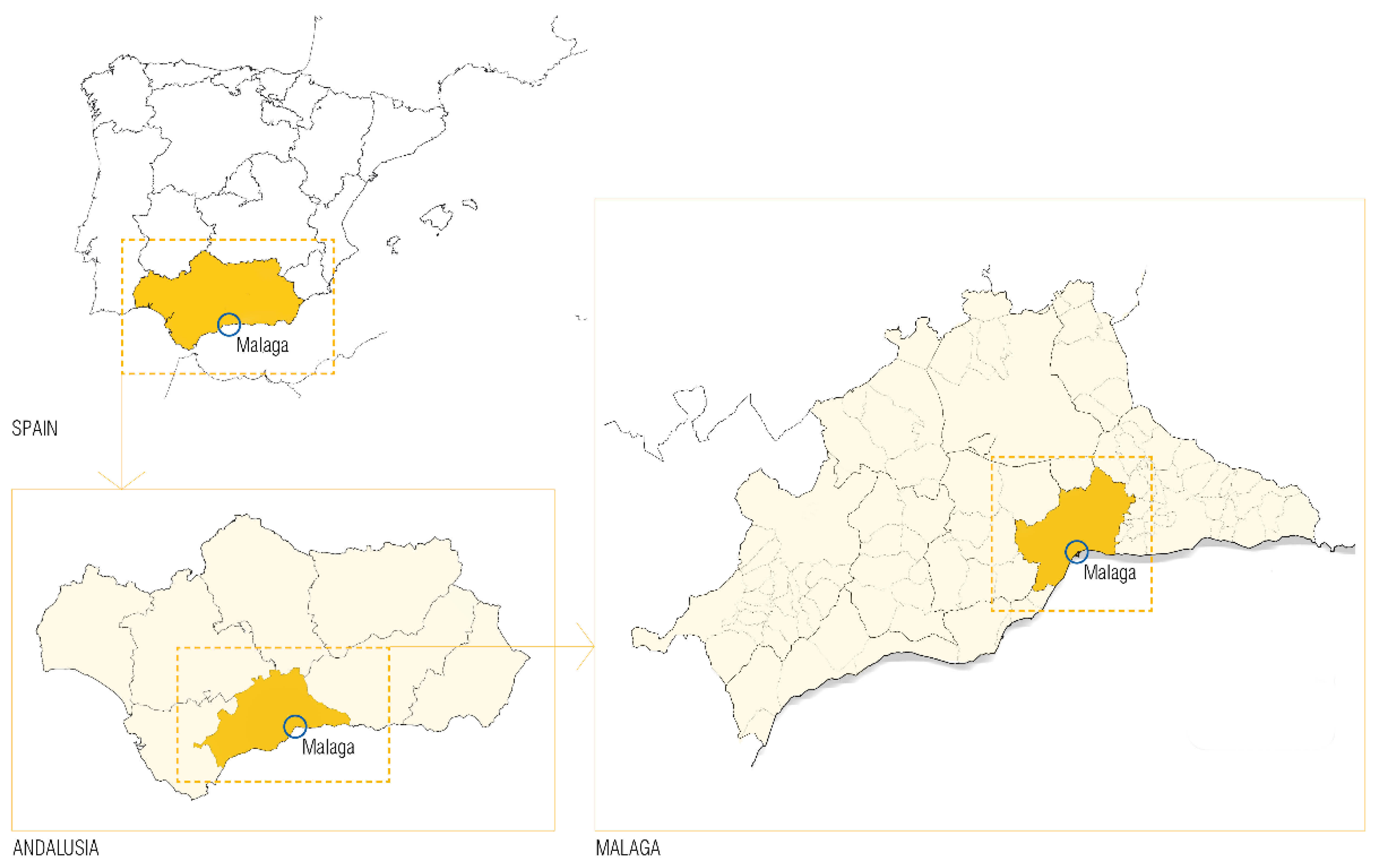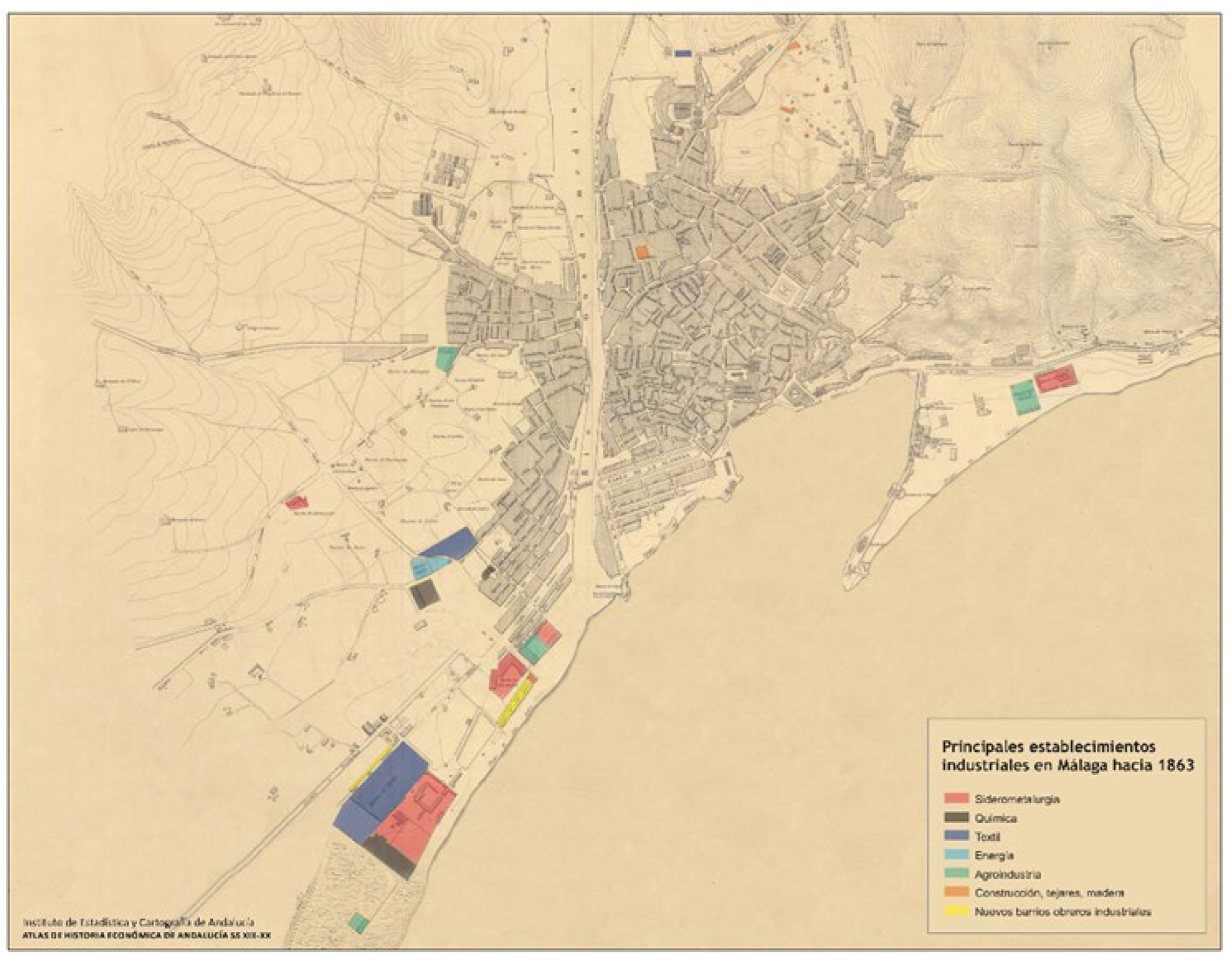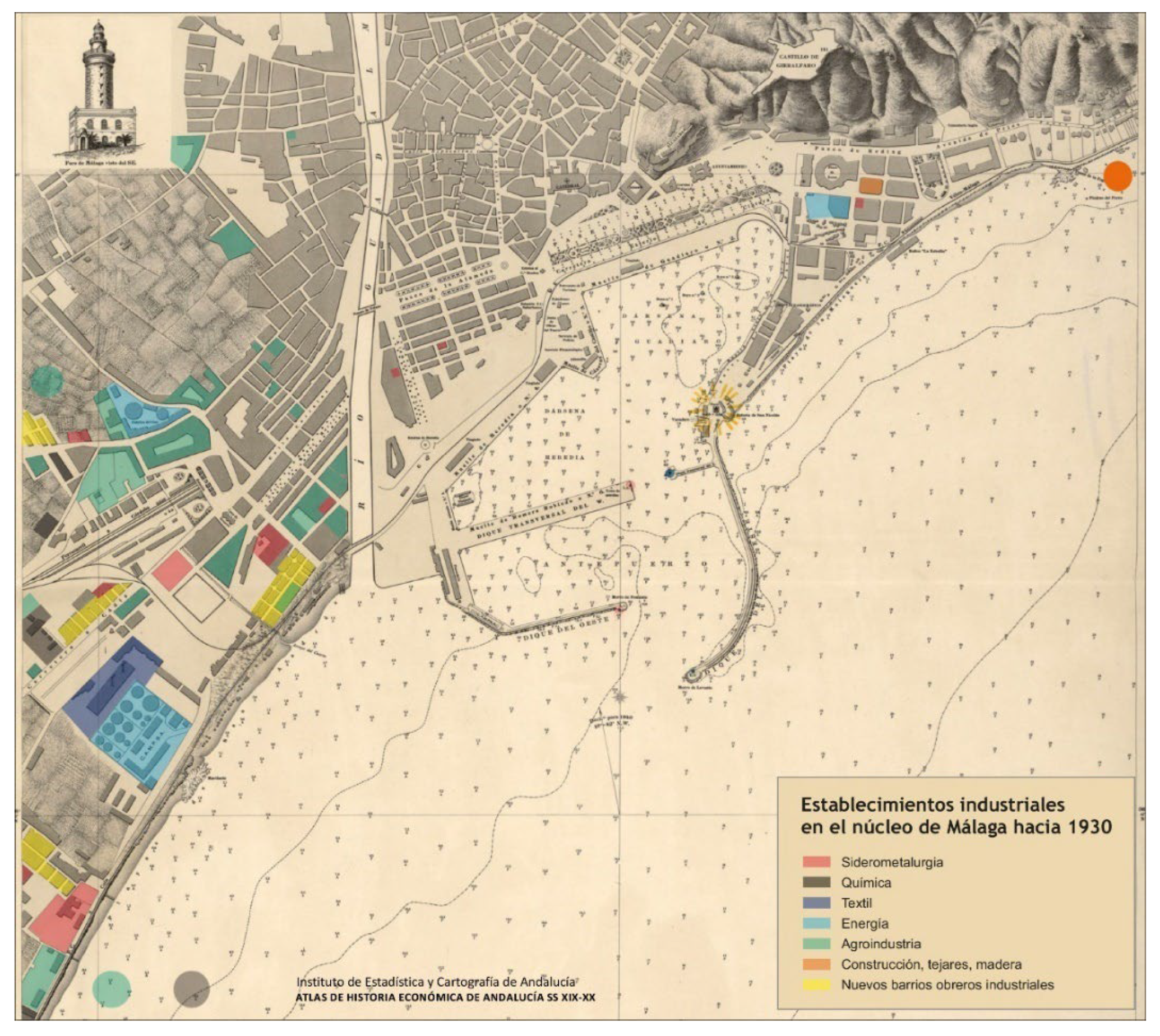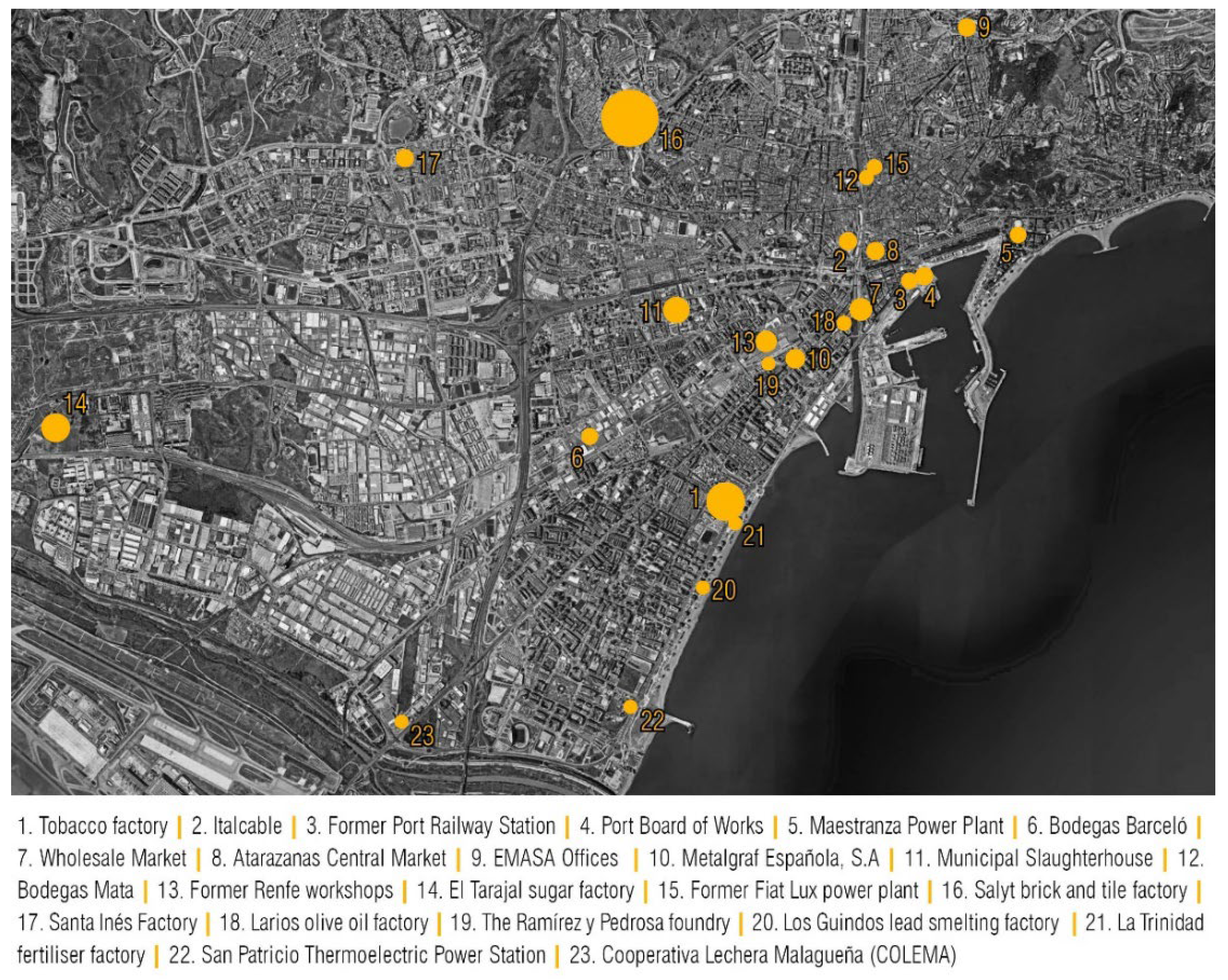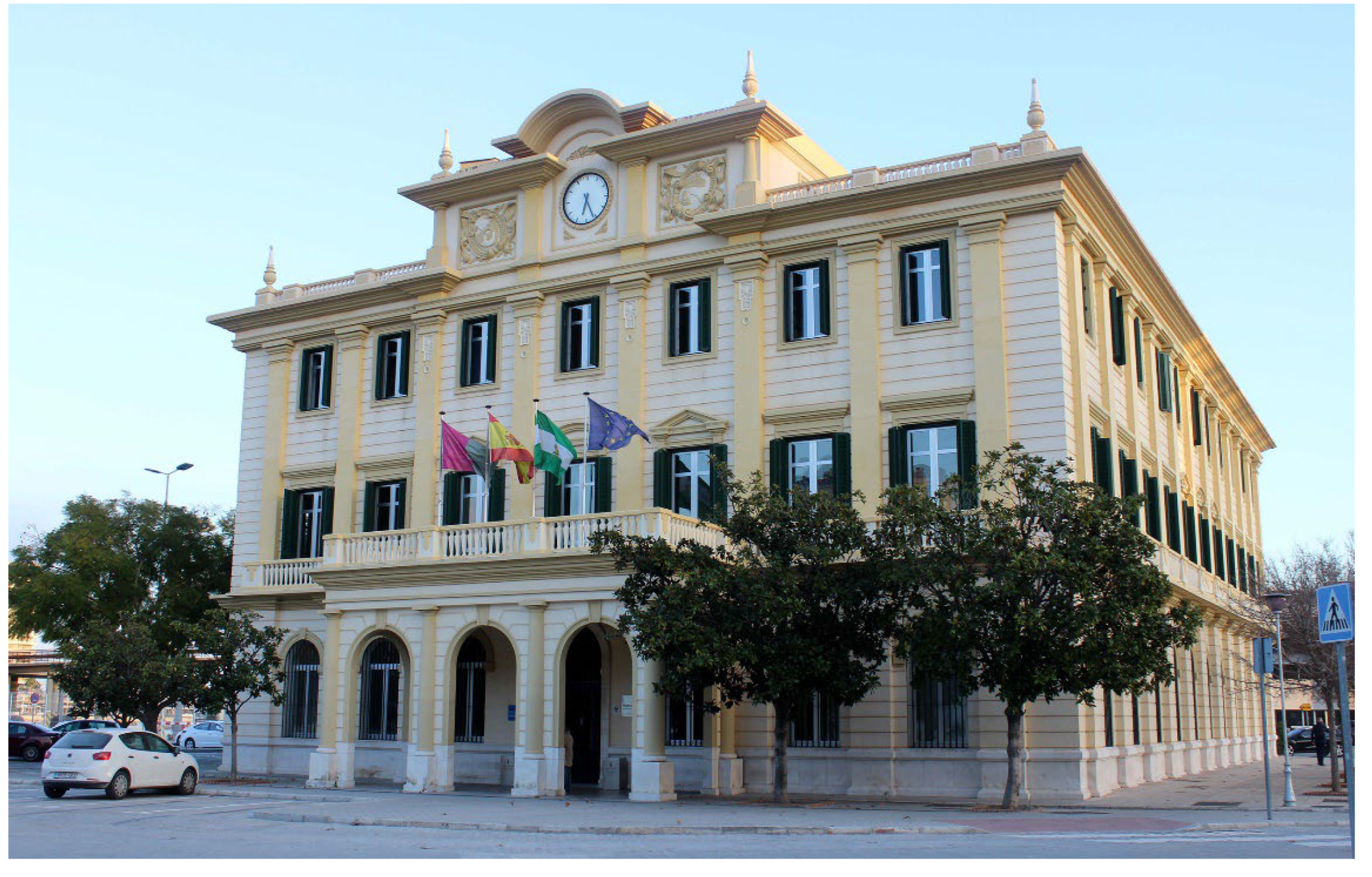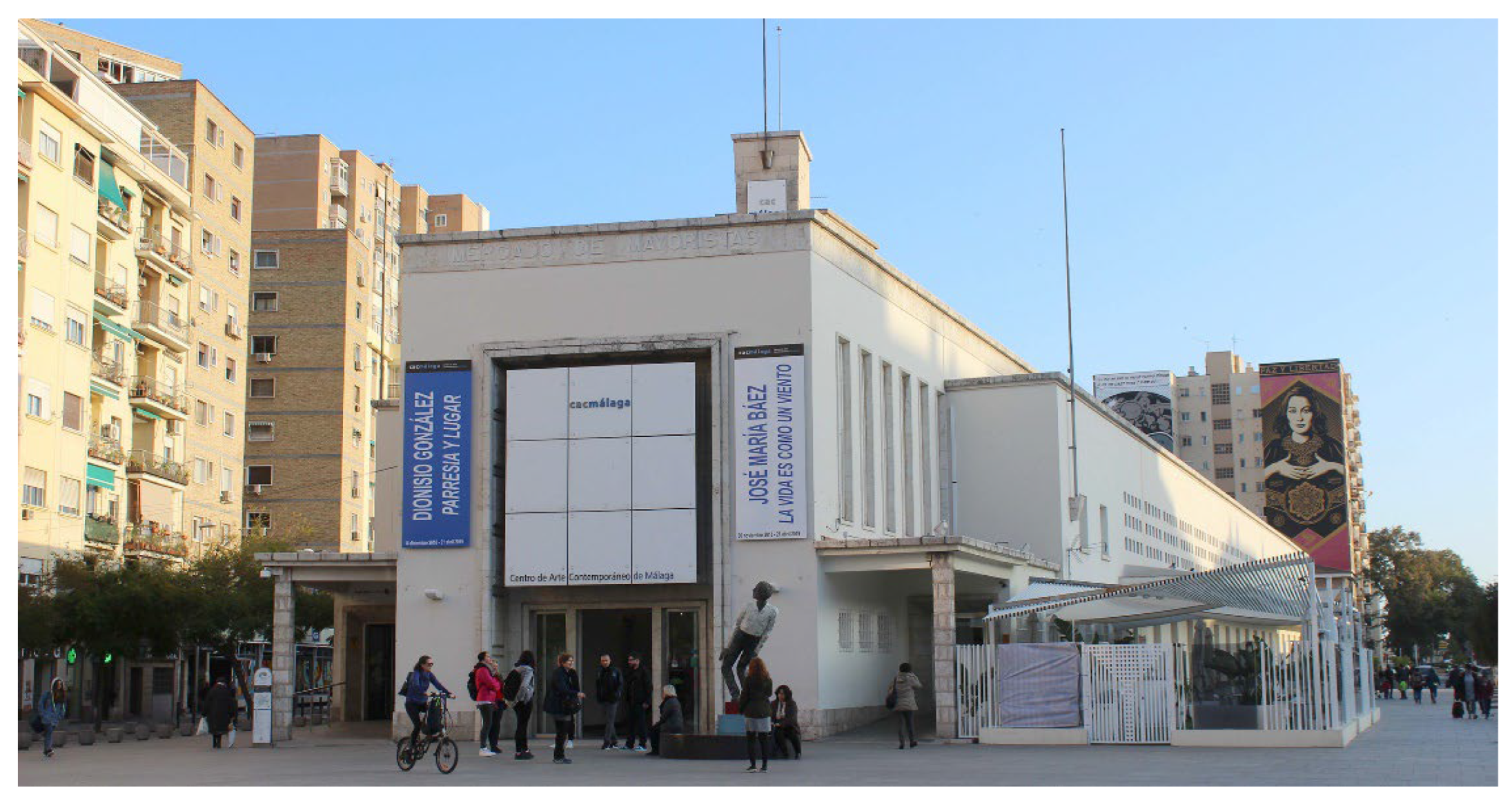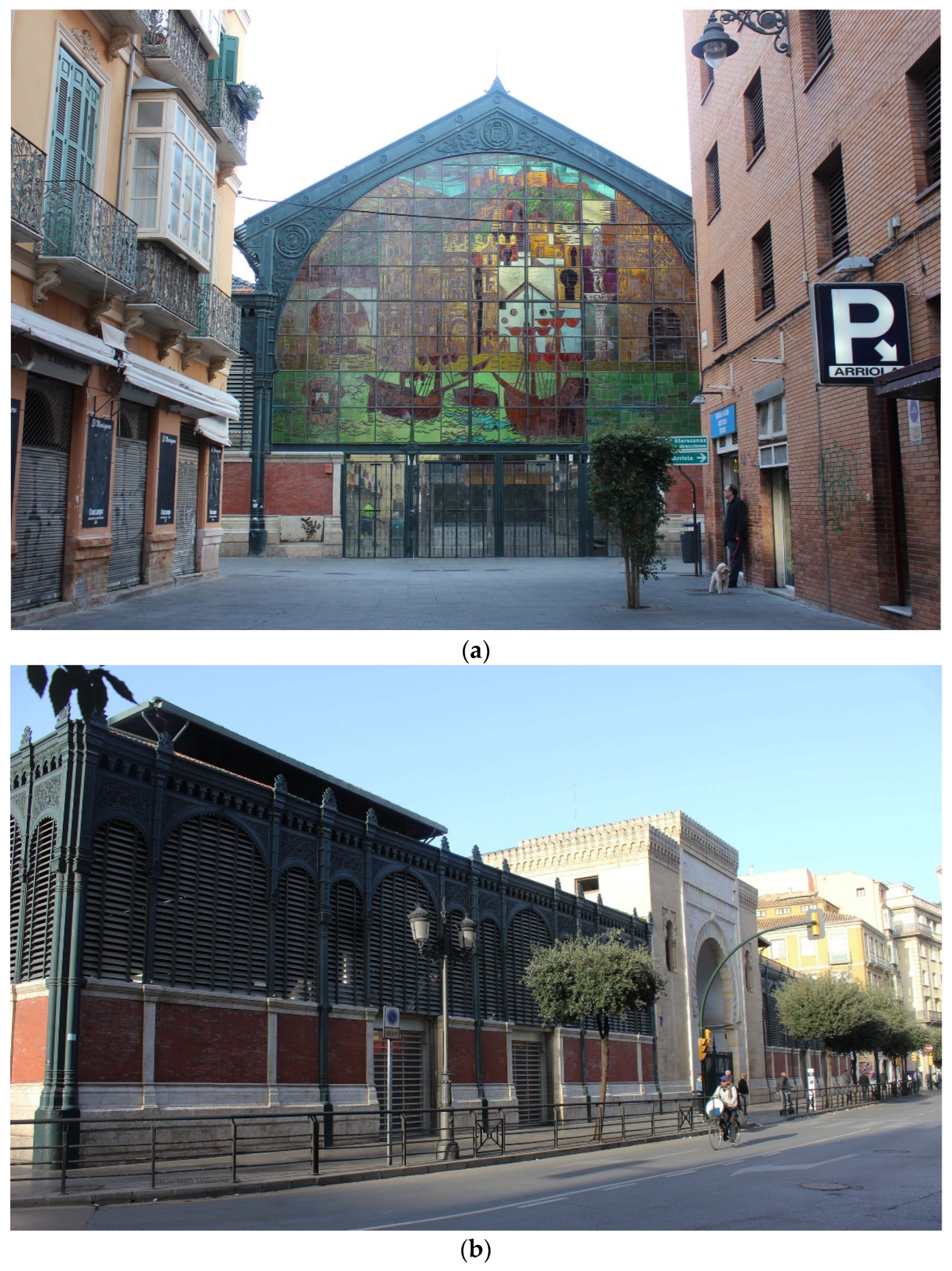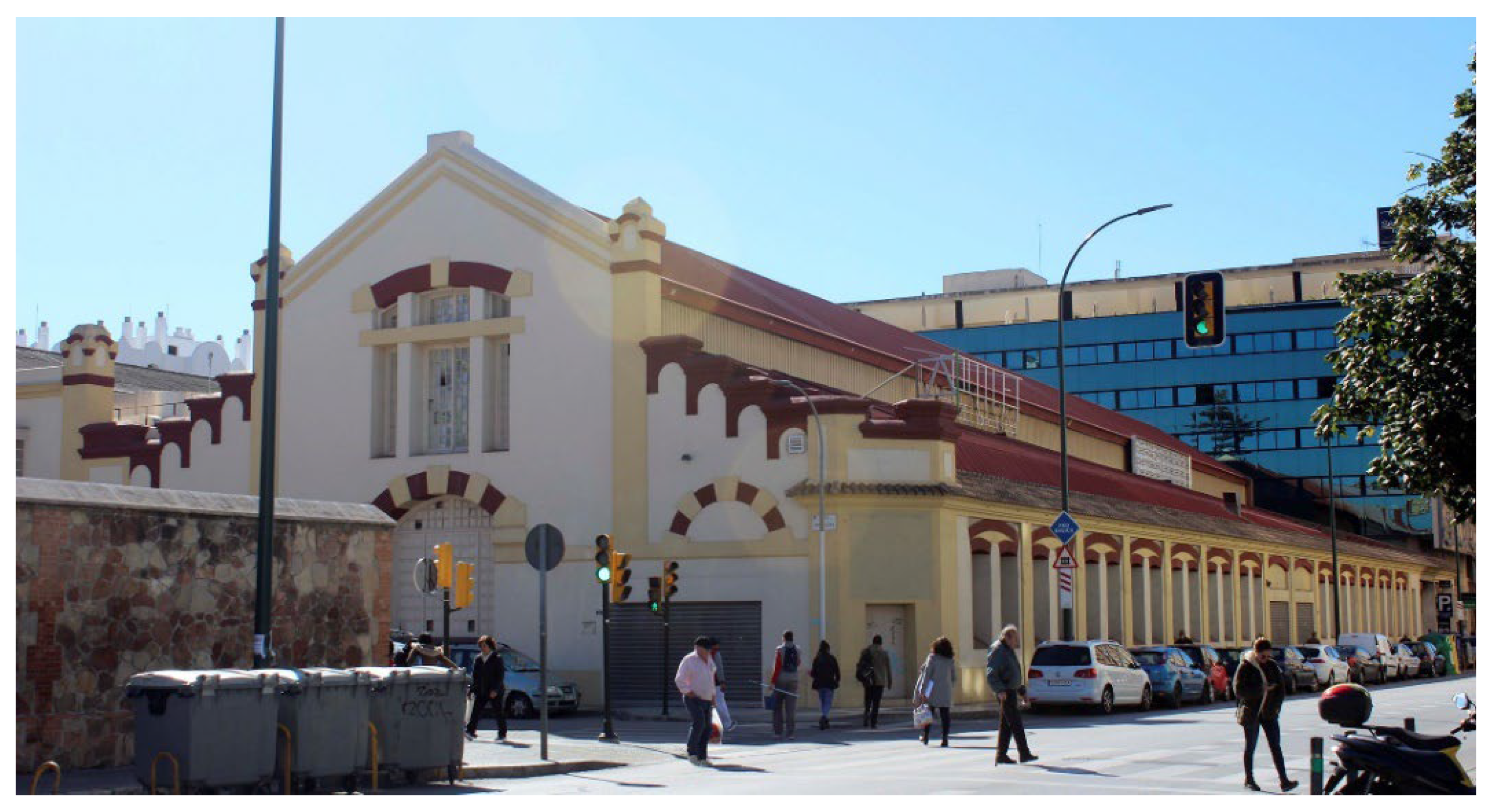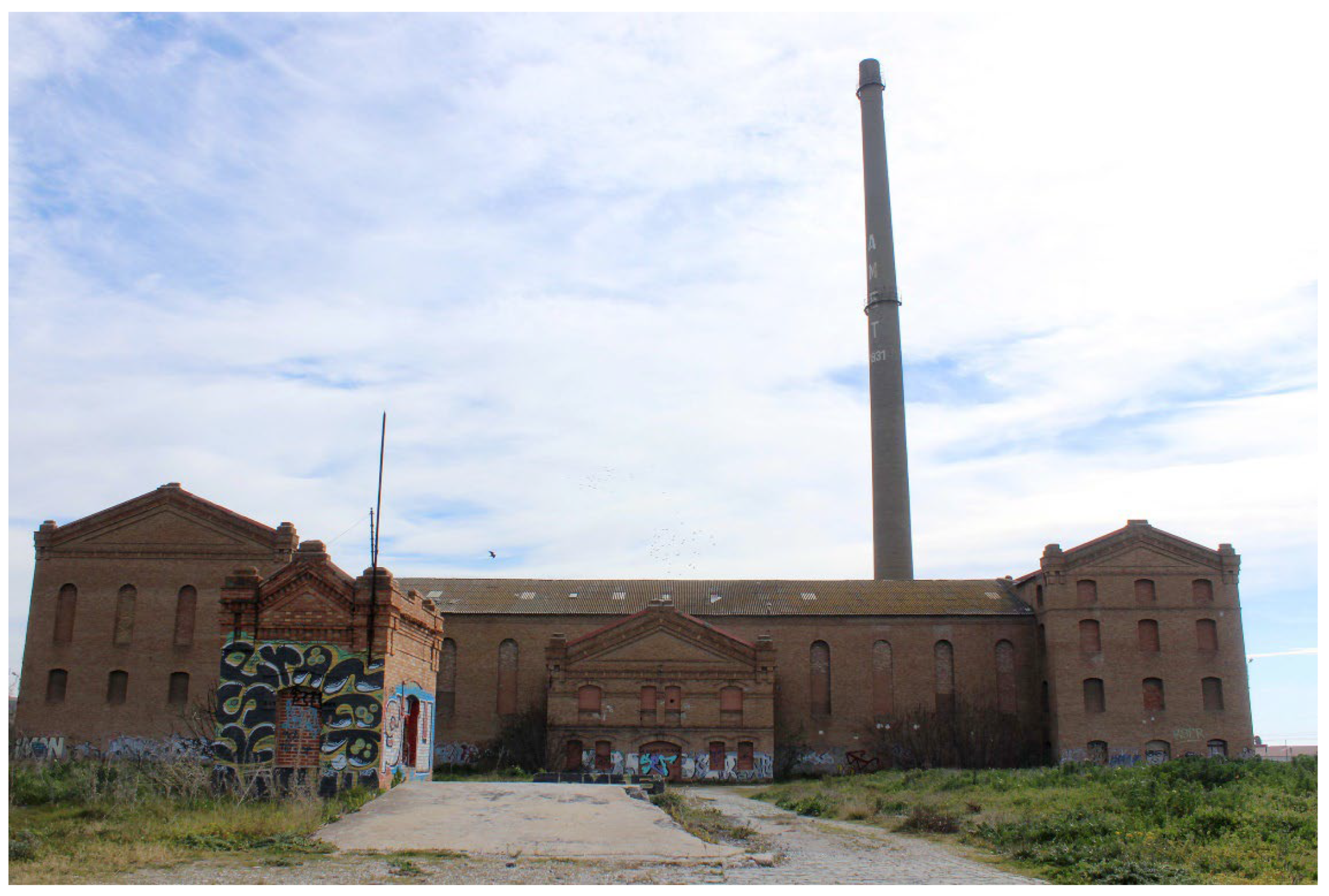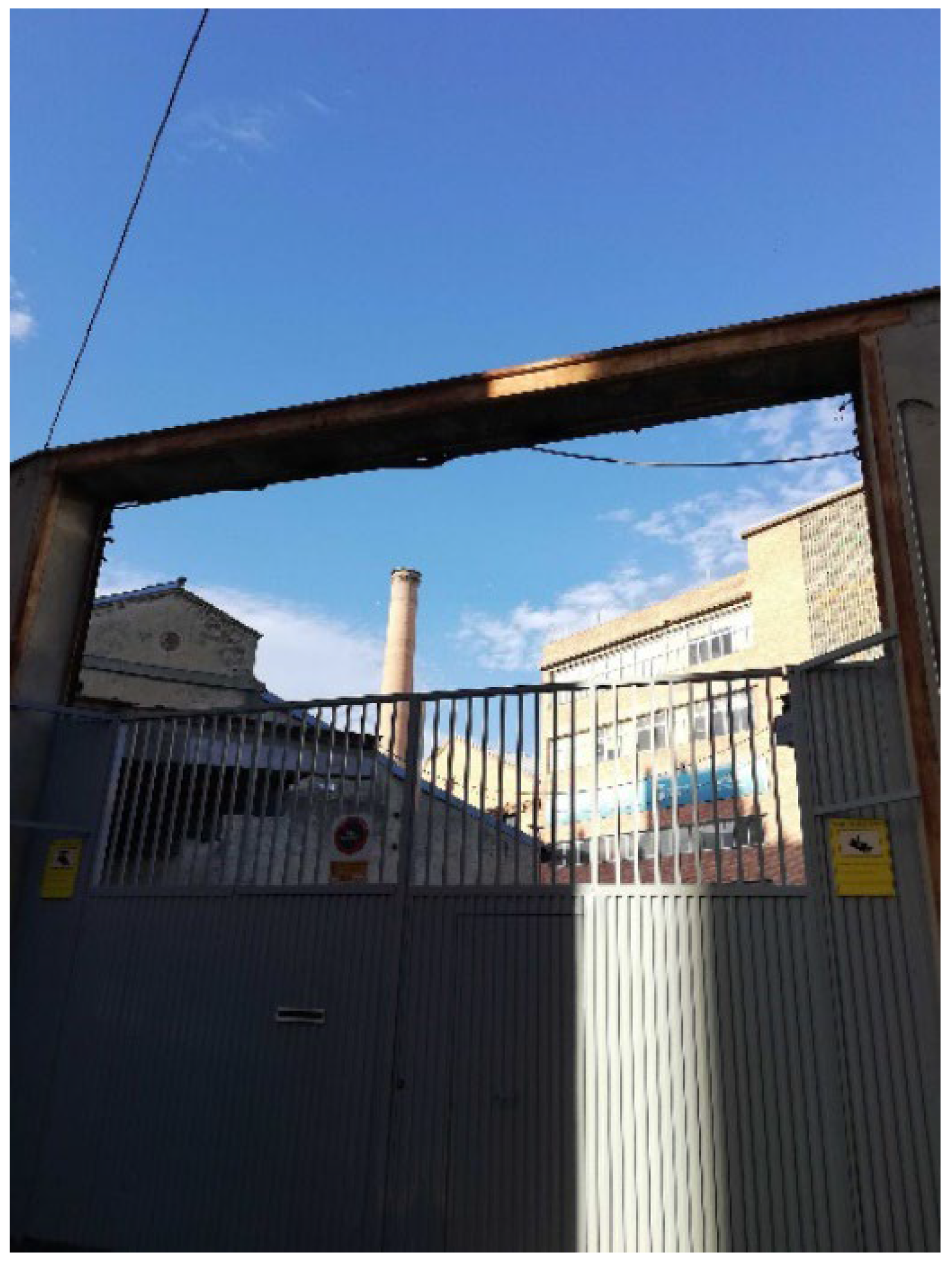3.1. Industrialisation in Malaga
In the last third of the 18th century, Malaga experienced considerable demographic growth and significant economic development on the basis of maritime trade relating to the export of agricultural products and their derivatives to the countries of northern and western Europe and the Americas.
Raisin and sweet wine production gave rise to a concentration of wine presses and raisin producers in the Montes and Axarquia regions, while the capital was home to ageing cellars for Malaga wines, sultana, and dried fruit export companies. Mills, presses, and stills for the production of flour, oils, and spirits were also located throughout the province.
In addition to commercial activity, Malaga was also notable for agricultural and manufacturing activities. Commercial exports from the port of Malaga, with close ties to speculative agriculture, gave rise to a significant accumulation of capital in the hands of an enterprising bourgeois core that was receptive to technological innovations from abroad, all of which established the conditions for the future industrial development of the city and province.
3.1.1. 19th Century Industry in Malaga: Boom and Development
In the 19th century, and up until the first decades of the 20th century, Malaga played an important role in the national industrial process [
3,
44]. In the mid-1850s, Malaga was at the forefront of national industry, experiencing its golden age during the decades 1830–1860 (
Figure 2). It was the second most industrialised city in Spain after Barcelona and was prominent in sectors such as the iron and steel industry. In the field of technology, it was at the forefront in terms of the incorporation of the most modern technology of the day [
45] and Malaga’s economy, based on metallurgy, textiles, and wine, expanded internationally with the support of the port [
46].
Iron, steel, and cotton were the sectors that marked the beginning of this industrialisation in Malaga, though this was not limited to these sectors alone, spreading, as it did, to include all industrial sectors [
4]. The commissioning in 1832 of the first national blast furnaces in Marbella, the La Concepción ironworks, marked the beginning of this intense industrialisation process in Malaga. In 1883, the decision was taken to divide the iron manufacturing process between Marbella and Malaga, where the first furnaces were built in the Constancia iron and steel complex [
47]. The success of iron and steel production meant that Malaga soon became the country’s leading centre for cast iron production, and one of the basic sectors of 19th century industrialisation was well developed before the 1850s [
48], one of the key figures in this industrialisation process being Manuel Agustín Heredia [
47,
49]. As a consequence of this iron and steel activity, numerous foundries and mechanical construction companies were established in the city and subsequently in other towns in the province from the likes of Antequera and Velez-Malaga.
Another characteristic sector of Malaga’s first industrial revolution was the cotton textile industry [
50]. In 1846, Martín Larios, who played a fundamental role in 19th-century industry in Malaga, founded a modern textile factory equipped with the latest British technological advances, La Industria Malagueña, which was to become one of the first modern factories in Spain. This was followed by other textile factories, such as La Aurora, in 1856, which, though smaller, employed the same technology.
Iron, steel, and cotton industries were subsequently joined by the chemical industry; Malaga being at the forefront in national soap production. Together with Barcelona, the city was also a pioneer in the manufacture of artificial soda, which contributed to the birth of the base chemistry industry.
In an similar fashion, the agri-food industry, which is linked to the farming trade, consolidated itself as the most powerful sector in the province during the 1840s and 50s, the traditional exportation of sweet wines, brandies, and sultanas reaching the highest levels of the century during these decades, placing it at the forefront in terms of national production [
51]. Sugar was another major industrial sector in the province, and while its origins date back to the Middle Ages, it was not until 1845 that it began its process of modernisation, mainly due to the efforts of Ramón de la Sagra, who founded the Torre del Mar sugar factory, which boasted the most state-of-the-art technology of the day. In 1851, this was acquired by the Larios family, who developed and modernised the sugar industry along the entire Mediterranean coastline [
52].
All this intense industrial production, in particular that linked to the agri-food sector, stimulated and lent prominence to port traffic in the city of Malaga, which in turn had an impact on other towns in the province, so industrial activity was not limited to the capital, but rather spread to provincial towns, albeit with varying intensity. In this context, worthy of mention are manufacturing activities in Ronda, Marbella, Vélez-Málaga, and Antequera, extractive activities the likes of lead mining and smelting in Estepona, white jasper quarries in Ronda, marble quarries in Coín, the iron and steel industry in Marbella; the sugar mills in Torrox and Vélez-Málaga; the cork stopper factories in Gaucín; as well as extensive flour mills, distilleries, tanneries, and potteries, among other enterprises, scattered throughout the province.
The area of greatest industrial expansion was along the coastline to the west of the river Guadalmedina. Malaga’s industrial space was structured into four main areas, Bulto, Huelin, Pelusa, San Andrés, as well as the new Perchel area. At the time, the historic centre of Malaga also featured a wealth of crafts and manufacturing establishments totalling more than a hundred small- and medium-sized businesses covering all industry sectors.
3.1.2. Late-19th and Early-20th Century Industry in Malaga: Decadence
Industry in Malaga experienced its first major crisis, one that was to affect all sectors, at the end of the 19th and beginning of the 20th centuries [
3,
53]. The lack of coal and the high price of importing the same, the rivalry with other iron and steel areas in Spain such as Vizcaya and Asturias, which were favoured and backed to a greater extent by foreign capital; the late implementation of the railway, phylloxera, which appeared in 1878 and led to the collapse of wine production from the 1880s onwards, problems relating to the marketing of cotton textiles and difficulties with marketing sugar cane were, among others, some of the reasons for this crisis, one that led to the closure of many businesses [
4,
54].
As a result of this crisis, the end of the 19th century saw a general decline in economic activities [
55] as well as a demographic decline in both the capital and the province [
4], a situation that meant that many Malaga residents had to look for other sources of income.
3.1.3. Industry in Malaga in the First Half of the 20th Century
The beginning of the 20th century saw a recovery of Malaga’s economy, though it would no longer hold the hegemonic position of the previous century [
4] (
Figure 3 and
Figure 4). Changes in the manufacturing, commercial, and financial structure led to the birth and consolidation of new sectors, and the agri-food sector continued to play a significant role, having ties to agricultural production in the eastern part of the region. The production, refining, and export of olive oil, the flour industry and the ageing and export of wine and sultanas were some of the sectors that experienced a new period of expansion in the first decades of the 20th century, while the packaging, cardboard, typography, and lithography sectors, with ties to the production of olive oil containers, enjoyed a golden age [
56].
Together with the agri-food sector, the chemical sector, with the production of fertilisers for agriculture, was one of the basic pillars of industry in Malaga at the time. Similarly, the construction sector experienced high levels of building activity due to the need for new workers’ housing. The demand for this construction activity led to the appearance of local industries providing ceramic materials (bricks, tiles, etc.), hydraulic tiles, and cement, among others. Likewise, metallurgy and mechanical construction enterprises were in full swing.
3.1.4. Industry in Malaga in the Second Half of the 20th Century
In 1959, with a National Stabilisation Plan that aimed to both stabilise and liberalise the Spanish economy, factories were opened in industrially underdeveloped provinces where unemployment was significant. In the case of Malaga, this marked the beginning of an era of opportunity and stabilisation, and a series of companies were founded that have constituted the industrial sector up to the present day [
57].
The need to resolve one of the most urgent problems, namely the insufficient electricity supply, led to the creation, in 1955, of the San Patricio thermoelectric power station on Misericordia Beach, known as La Térmica. This was inaugurated in 1958 and remained in operation until 1980, when it closed due to technological obsolescence and the high price of oil.
Around this time, the Intelhorce textile company was established by the National Institute of Industry (INI), thereby helping to sustain an industrial sector with a long tradition in Malaga [
58]. In the 1960s, the Spanish Ammonia factory, located opposite Intelhorce and dedicated to the production of nitrogenous fertilisers, was founded in an effort to satisfy national agricultural demand and fitted with the most advanced technology of the day.
The establishment of the Compañía Internacional de Telecomunicación y Electrónica S.A. (CITESA) was approved on the Martiricos site, and equipped with modern technology. In 1995, it moved to the Parque Tecnológico de Andalucía following rezoning of the site, and since 2000, the company has passed through the hands of various multinationals. The Martiricos building, despite its listing as a unique example of the modern architectural movement in Spain, was demolished between 2009 and 2010.
3.1.5. Industrial Decadence in Malaga
In the aftermath of the civil war, the economic situation in Malaga was one of recession and stagnation within a context of unemployment, strikes, and violence [
59], and the few industries that arose during Franco’s developmentalism period disappeared in the 1980s and 90s. In this situation of crisis in the mid-20th century, few significant industries still operated in Malaga: Industria Malagueña, the La Araña cement factory, the La Trinidad fertiliser factory, the Amoniaco Español factory, the Vers foundry, and the Los Guindos lead foundry being among them.
The disproportionate, chaotic growth of the city from the 1960s onwards, coupled with the shifting of its main function from an industrial to a service-oriented, residential city meant that many of the remains of this industrial heritage, mostly 20th century companies that had survived to this date, disappeared. In addition, at this time, the percentage of the working population engaged in local industry was very low and the first major tourist developments were taking place [
44,
60]. The 1971 general plan moved productive activities away from the city and encouraged the conversion of industrial land into residential land, an event that sparked the notable speculation-construction operation of the 1970s.
As many as 121 Malaga companies closed in 1972, many of these industry related. Other developments in the city, such as those that occurred during the 1990s and 2000s, all but erased what remained of the industrial Malaga of the 19th and first decades of the 20th century, with Intelhorce, CITESA, the fertiliser factory La Trinidad, Metalsa, and Tabacalera, among others, closing down.
All of this has led to the fact that, today, hardly any architectural evidence of this rich industrial past remains, and those elements that have survived are in a very poor state of conservation. The same can be said of the blue-collar and industrial districts, which have either been demolished or have seen their structure and buildings drastically altered.
3.2. The Built Industrial Heritage Situation in the City of Malaga Today
The 1980s and 90s coincided with years of rampant speculation that led to the rapid disappearance of many of these industrial sites [
61]. Faced with this situation, in 1999 an inventory study was carried out of the remains of the industrial facilities in the municipality of Malaga. This study was entrusted to the architect José Ignacio Díaz Pardo, who presented a catalogue of some 300 industrial constructions from which he selected 47 elements, including buildings, chimneys, and even entire neighbourhoods, that he considered worthy of protection measures and proposed the following priority lines of action for these [
62]:
A. Non-optional architectural protection with absolute priority:
This line of action envisaged the comprehensive protection of 12 existing chimneys and their restoration as the only possible means of intervention. The records pertaining to the chimneys should contain some conditions relating to the environment and their administration with a view towards their conservation should be foreseen.
B. Urban design interventions:
The creation of an urban design project, such as the Park Museum of Industry.
C. Non-optional architectural protection with absolute priority:
The drafting of urban planning regulations for the protection of residential complexes the appearance of which were linked to the industrialisation process, for example the blue-collar neighbourhoods of El Bulto, La Pelusa, Huelin, La Isla, Colonia de Santa Inés, La Sauceda, and La Araña.
D. Non-optional architectural protection with absolute priority:
Architectural protection for 16 buildings, some of which at the time were already protected, while others were classified as public utilities or infrastructure, meaning their future use could be made compatible with their conservation.
E. Active industries:
Thirteen elements were identified for which their proposed change in use was not acceptable and the protection of their architectural elements was considered.
F. Creation of the Museum of Industry:
The creation of the Museum of Industry in the Corchera del Tarajal.
The report filed by the town planning department on this inventory assumed almost all the proposals that architect Díaz Pardo included in this inventory. Many of these, however, have not been carried out, such as the creation of the Museum of Industry or the Park Museum of Industry. Neither have the protection actions proposed in this document been implemented, with the result that the condition of these elements is very different today. The truth is that more than a third of the 47 buildings proposed for protection by the architect no longer exist [
63], and the Silo del Puerto (port silo), the Tomás Trigueros foundry, Olivarera Peninsular olive oil factory, and Santa Inés ceramics factory chimneys, the house of the director of the La Araña cement factory, the Campsa warehouses, a Renfe workshop, the railway station itself, the ammonia factory and the Aceites Minerva plant, among other constructions for which the inventory advised protection, have disappeared. Thus, without being exhaustive, we find the following main examples (
Figure 5).
3.2.1. Restored and Well-Preserved Industrial Buildings
The former tobacco factory, known as Tabacalera, is located in the Huelin neighbourhood, a 19th-century industrial expansion, and was designed by engineers Juan Francisco Delgado, Carlos Dendariena, and Fernando Guerra. Its construction in regionalist style began in 1923 and ended in 1927. The factory was conceived based on the layout of 11 pavilions around a central landscaped space whose location was planned to allow the different phases of production to be independent, but also to optimize productivity, avoiding unnecessary transport and manoeuvres. Six of these pavilions are arranged symmetrically with respect to the central space and the other five, dedicated to storage, are arranged on the southern edge of the plot. In this symmetrical composition, the two buildings dedicated to Offices and the Registry advance to mark the main access to the complex. Both are topped with a tower marking the entrance.
From 1929 to 1975, this industrial complex operated as a tobacco leaf fermentation centre until 1975 and subsequently as a production centre up until 2002. It closed its doors in 2002 and, in 2004, passed into public, municipal ownership of the Malaga city council, which decided to recover this industrial complex for cultural and administrative uses.
Following refurbishment by architect Francisco Eguirior, the former drying sheds were opened to the public in 2007, housing the public tax administration office (Gestrisam) as well as other municipal bodies the likes of the municipal computer centre (Cemi), the social welfare department, the women’s services department in 2010 and the centre for unified control in 2015 [
15]. In 2010, the main building became home to the Automobile Museum of Malaga and, since 2015, has housed the headquarters of the St. Petersburg Russian museum collection. The different recovery and reuse actions carried out have respected the original exterior spaces and integrated new constructions without distorting the initial configuration of the complex (
Figure 6).
The tobacco factory is currently a fundamental testimony of Malaga’s industrial past and an icon of the city. In addition to its historical and ethnological value, this industrial complex has a high architectural value represented in the large scale of its intervention, in its functional architecture, and in its different buildings built with a careful Andalusian regionalist style [
15].
The Italcable building, located in the Perchel neighborhood, was the headquarters of this Italian company whose objective was to install submarine cables to facilitate telephone communications between Italian emigrants in Latin America and Italy.
The building, a large warehouse that had formed part of the Santo Domingo convent until its seizure and sale, was adapted in 1925 to house the company’s headquarters until it closed in 1970, possibly due to technological obsolescence [
64]. It remained abandoned until 1999, when it was refurbished by the Cofradía de la Buena Muerte (Brotherhood of the Good Death) as an exhibition hall under the direction of Álvaro Mendiola and Antonio Díez Casado. The Italcalbe Room, located on the first floor, currently hosts plastic arts and photography exhibitions as well as works by established local artists. Likewise, the Italcable building currently houses the Technological Headquarters of the International University of Andalusia (
Figure 7). This building, in addition to its architectural value, has a historical and ethnological value as a witness to the industrial past of the city.
The former suburban railway company station is located in a building at the entrance to the port area. This building, which was constructed by the architect Enrique Verdú together with the engineer Leopoldo Werner, dates to the first decade of the 20th century. It is a two-story free-standing building with a floor area of 335 square metres located on a plot of almost 500 square metres. Its function was to provide coverage for the local railway network linking Malaga capital with Coín, Ventas de Zafarraya, and Fuengirola.
The building has two well-differentiated façades, on the one hand, the one that opens onto Avenida Manuel Agustín Heredia that defines an angle at whose vertex the accesses are located and, on the other hand, the one that opens onto the sea, which is more functional and whose layout responds to the layout of the narrow tracks through which the suburban railways of the port circulated. The façade on the ground floor is formalized with a stone finish and on the first floor brick. The building is topped with a cornice and a stone balustrade.
All the lines departing from this station were closed in the 1960s, with the exception of the Fuengirola line. The disappearance of its lines and many of its elements such as passenger ticket offices, offices, waiting rooms, lockers, platforms, etc., made that only the stations and halts stand as testimonies of this past.
The Malaga Suburban Railway station building became the property of the port authority and after years of neglect, it was decided to carry out a restoration and rehabilitation project. In 1996, the building was restored by Juan Pablo Gómez de la Fuente and now houses the headquarters of the Port Studies Institute. The different interventions focused mainly on the conservation of the façade, on the assembly of a metallic structure to guarantee the stability of the building and the conditioning and rehabilitation of its interiors.
This building was designed by the civil engineer Manuel Aceña González. Its construction began in 1932 and ended in 1936, although its final reception did not take place until 1943 due to the events of the civil war. This free-standing rectangular building is located in the port area in the Plaza de la Marina. It has three heights and is finished off in the central area of each of its façades by a coronation body that incorporates a clock. On three of its faces there is an access body on the ground floor that is finished off on the first floor with a balustrade. The design of its facades, inspired by the emblematic Lonja de Barcelona, has a classicist appearance. In them a very accentuated order of pilasters between holes can be observed, both on the ground floor with a stone plinth, and on the first and second where the pilasters are continuous. Likewise, crowning finishes with pinnacles and decorative details can be observed. The main façade is oriented to the east. The set presents a classical, symmetrical, and harmonic design. Inside, the imperial-type staircase that borders an interior patio stands out. All these elements give this building an architectural value that adds to its historical and ethnological value as a witness to the industrial past of this city. It currently houses the Malaga port authority (
Figure 8).
The former power station of The Malaga Electricity Company, commonly referred to as the Compañía de los Ingleses (The English Company), was the first electricity production company to be established in Malaga and distributed energy to four areas of the city. In 1888, the city council authorized this company and the French Elctrecité Industrielle to lay public lighting in Malaga. In 1896, the English company acquired the site for the construction of the electricity factory on it. The project signed by the architect Eduardo Strachan in November 1896 is Neo-Mudéjar in style and very simple. On the plan, the patio, the chimney, the engine room, and the boiler room for burning coal stand out, as well as the administrative units. The thermal power plant stopped working at the beginning of the 20th century.
In 1921, due to the numerous losses that the company had suffered in recent years, a new company was formed, Eléctrica Malagueña, which took over the factory and, in 1922, promoted the construction of new premises. This new company moved its official headquarters to the building on Maestranza Street, designed by Eduardo Strachan and Viana-Cárdenas, which was extended and modified according to a project design by engineer Juan Brotons [
65].
In 1958 the factory suffered a fire that rendered it completely unusable, the section of the building designed and constructed by Brotons being the only part that was preserved. This was located next to the old chimney, which continued to be used sporadically for the burning of scrap metal. The building remained in ruins until, at the end of the 1970s, the Compañía Sevillana de Electricidad signed an agreement that included its restoration. In the early 1980s a housing development was built on the large rectangular site and only part of the courtyard and delimiting corridors were preserved, these being refurbished for use as the offices of the company. The original piece of the chimney from the old electricity factory is of great value as it is the only vestige that remains of the first electricity producing factory in Malaga. This remains one of the few examples of the incorporation of electricity in public lighting in the city.
The wine company Hijos de Antonio Barceló was founded in 1914 and, in 1967, moved to the Ronda exterior industrial estate, where the building to house the Bodegas Hijos de Antonio Barceló S.A. (Bacarlés) was built in 1968. The main building built to house the offices of the winery and the aging cellar with a capacity of about 10,000 barrels of wine is an excellent example of a regionalist–historicist-style building belonging to the industrial past of this city of great value.
This building built in exposed brick has a symmetrical façade with historicist lines with two lateral bodies with two floors and a central one with three. The entrance door is flanked by columns that are placed on high pedestals on the ground floor. Inside there is a central patio with a square plan delimited by porticos with semi-circular arches peralted in exposed brick supported on white marble columns.
This building housed the Bodegas Barceló until 1998, when the company relocated to Valladolid and closed its facilities. The building was acquired in the same year by the Illustrious Official College of Doctors of the Province of Malaga, when it was refurbished and adapted as the headquarters of the college by architect Enrique Mañas Millán.
The former Malaga wholesale market (Mercado de Mayoristas) was designed by architect Luis Gutiérrez Soto and is located on the left bank of the Guadalmedina estuary. This building, in addition to its historical and ethnological value as a witness to the industrial past of the city, has great architectural value as it constitutes one of the foremost examples of Andalusian rationalist architecture [
66]. Its origin is framed in the context of avant-garde architecture supported and promoted during the Second Republic. It was originally conceived as a free-standing building with a trapezoidal floor plan that adapted to the singularity of the site on which it was erected.
It has three floors, one of them, the basement, below ground level that partially occupies the site. It is built with a structure of pillars, beams, and a reticular-reinforced concrete slab. Volumetrically, two parts can be distinguished, a header piece that is located on the smaller side of the trapezoid where the main access is located and that runs through the administrative offices and, on the other hand, the central body of the market that constitutes an open-plan empty space. Some lateral bays enclose this central space whose roof is located higher than the rest of the naves. In this way, the roof of this part of the building is solved in a terraced way, the highest level coinciding with the central area. Both parts, the head and the central body, intersect, leaving the head body slightly raised above the rest of the building. On the axis of symmetry, coinciding with the point where both pieces meet, is the prismatic tower that rises above the rest of the building. On the outside, the building is surrounded on the perimeter by an unloading platform protected by a concrete canopy. In its design, horizontality predominates, which is broken by the presence of the tower.
The commission for the construction of the building was carried out in 1937 by the architect Luis Gutiérrez de Soto, although the construction management was supervised by the municipal architect Eduardo Estévez Monasterio, and the work was received in 1944. It is, therefore, one of the few projects whose start and completion takes place between the end of the civil war and the first post-war years.
In 1944 it opened its doors and remained in use until 1980 when, due to the changing needs of the city, a new market was built. From then until the year 2000, it served a variety of ends that led it into a process of abandonment and deterioration. In 1998, the architect Miguel Ángel Díaz Romero was entrusted with the rehabilitation project of the building to turn it into the headquarters of the Contemporary Art Centre of Malaga (
Figure 9). From 2000 to 2003, the building was refurbished and adapted for this use following a project based on simplicity and respect for the original project. The different actions focused on the recovery of the façade and the exterior spaces of the building and the adaptation of the interior space as an exhibition area.
The Atarazanas central market was built on a site formerly occupied by a naval workshop of Nasrid origin, hence the origin of its name (atarazana–boatyard).
The building was designed in 1871 by the architect Joaquín de Rucoba and its construction took place between 1876 and 1879. It is one of the first metallic projects designed entirely in Spain [
67]. Its design was marked by the need to integrate into the new building the old arch of the Atarazanas gate, from the Nasrid period, on whose site the market was to be built. This exceptional circumstance in those first years of safeguarding the architectural heritage makes this project acquire a peculiar and unique character, with few examples from that time in which both aspects can be seen together. This project, a symbol of progress and modernization, also became a benchmark for recovery and respect for a Muslim past [
67].
The slightly trapezoidal building is structured in three naves. Its metal structure was made with industrial castings from the Sevillian steel industry. In the enclosure, stone and brick masonry are also used. The door of Nasrid origin is located on its main façade while on the back of it there is another metallic door in the shape of a triangular pediment to which a large semi-circular arch opens with a decorated stained-glass window.
From 2008 to 2010, the market was refurbished in an effort to improve facilities by the company Sacyr Vallehermoso. These works included replacing the roof with a translucent covering of similar appearance to the original, revitalising of the Atarazanas port area, and excavation of the archaeological remains found in the subsoil (
Figure 10).
In the Olletas district, which at the beginning of the 20th century was the most highly populated area of the city, a series of tanks and buildings for the supply of drinking water were built in the 1920s and 1930s. The building housing the water distribution control centre was refurbished and now houses the EMASA (Malaga Municipal Water Company) administrative offices.
3.2.2. Restored Industrial Buildings in More or Less Acceptable Condition
Notable in its day for its use of cutting-edge lithography technology on metal, this industry, dedicated to the manufacture of metal containers for food products, arose as a result of the boom in the olive oil refinery sector in Malaga and the need for solid containers for export that displayed the manufacturer’s stamp [
68]. This factory became the undisputed leader in the sector, not only in Malaga, but throughout Spain.
The original building housing the company offices, designed by architect Fernando Guerrero Strachan in 1918, was U-shaped, adapted to the rectangular shape of the site and bordered by the streets Ayala, Góngora and Héroe de Sostoa. The factory was organized around two naves of different lengths with a double-pitched roof to which were attached two shorter side naves with a mono-pitched roof. These two main naves were connected by a central nave where the main access was located, followed by a large courtyard. The main façade facing Gongora Street had three bodies: the lower central one and the two higher and equal ends that were arranged to form a symmetrical façade. On the outside, the different openings were framed by lowered brick arches.
When the factory was destroyed by a fire, the building was rebuilt and extended by architect Enrique Atencia Molina in 1946 [
69]. In this reconstruction, the smaller nave was extended until it coincided in length with the nave on the right, and the uralite roof was removed from the two naves, replacing it with a cement one. Likewise, some façade elements were altered with respect to the original project.
This industry remained in operational until 1982, when it closed due to competition from new packaging materials, the emergence of new production technologies, and high production costs. In 1987, it was acquired and rehabilitated as a shopping center. As it is a building designed by the renowned architect Fernando Guerrero Strachan, it enjoys urban protection, so it has not undergone major changes in its structure and façades. In 2000, it was acquired by another large company for commercial use, which respectfully restored its façade and the section of Góngora street where the main entrance to the shopping centre was located. In 2017, the Tax Agency temporarily located its headquarters in this building where it continues today (
Figure 11).
The Municipal Slaughterhouse was designed by architect Fernando Guerrero Strachan in 1928 and built between 1929 and 1937 on the Carranque estate, now Conde de Guadalhorce Street, with the aim of replacing the former slaughterhouse. This project contemplated an innovative model with respect to the slaughterhouses projected in the city to date. Within a walled enclosure, the building integrated a series of warehouses, each having a specific function, and gardens.
All the warehouses were projected with a rectangular floor plan and a single height with a gabled roof. They had large windows to provide sufficient ventilation and a longitudinal skylight on the deck. Although each of them contemplated a different external image, they all responded to the same eclectic and historicist imprint; however, the building that housed the management offices was designed by the architect under a Neo-Mudéjar imprint, also typical of the time. This one contemplated two stories high, except in one of the corners that reached three. The roof was hipped and the openings in the façade were solved with semi-circular arches.
At the end of the 1980s, the slaughterhouse closed as a result of changes in health legislation and remained in disuse until 1998, when it was occupied by an association that used one of its buildings as an exhibition space for youth art. Shortly afterwards, several buildings were demolished in order to build housing, and today only four buildings have been preserved, these having been adapted by the town hall to house various municipal services.
3.2.3. Poorly Preserved and/or Abandoned Industrial Buildings
The Bodegas Compañía Mata–Unión de Bodegas Andaluzas emerged in 1917 as a winery group after the acquisition of the veteran Adolfo Príes wineries by the businessman José Mata Marrodán in 1916. The latter, associated with his brother, transferred the wineries located on the beaches of La Caleta to a large two-story industrial building built in 1917, dedicated to the aging of wines and the preparation of nuts for export located at the corner of San Rafael and Purificación streets. Its exposed brick construction attends to aspects of rationality and industrial functionality. Its typology is similar to that of many European factories from the late 19th and early 20th centuries. The most relevant façade is the one that presents Purificación street organized by wide lintelled openings. It should be noted its design that starts from the purification of a certain 19th-century historicism to approach the then nascent rationalism of the Modern Movement [
70].
These cellars remained in use until the 1970s. Following cessation of this activity part of the area was used for the construction of the headquarters of the pharmaceutical cooperation COFARAN. The rest of the facilities are still standing today, albeit in a state of abandonment.
This building was constructed in the early 20th century to house the central workshops of the former Compañía de Ferrocarriles Andaluces (Andalusian Railway Company) in Malaga, the third most important railway company in Spain at that time, whose national headquarters were in Malaga. After this company was nationalized in 1936, it changed its name to house the Renfe workshops. These are located close to the railway station and are formalized in a rectangular-shaped warehouse that includes a constructed area of more than 3100 square metres. They are entirely built with stone and steel and have a gabled metal roof.
This building is currently owned by the Administrador de Infraestructuras Ferroviarias (Adif). Despite their architectural relevance, these workshops do not have protection and are not included in the catalogue of protected buildings of the general plan for urban zoning.
In 2010, in celebration of the Malaga metro works, the façade was dismantled stone by stone and its length shortened under the promise that once the works were completed, the façade would be replaced. This promise, however, has not been kept, and today the building remains abandoned and in disuse.
The El Tarajal sugar factory is currently the only example preserved in the city of a steam-powered sugar mill and one of the most relevant examples of the industrial past of the city of Malaga. Its creation was promoted by prominent members of the city’s business and political oligarchy. The building, the work of the architect Manuel Rivera Vera [
71], began construction in 1925 and came into operation at the end of 1931. It was technologically prepared for the transformation of both sugar cane and beets. However, it was only in operation for a few years, since in 1939 it was dismantled and put out of use. From 1945, it was used as a cork factory, maintaining this activity until the 1960s. Hence, it is also known as “La Corchera”. Later, the building was abandoned, being used sporadically for the stay of animals.
This factory is located on the outskirts of the city of Malaga, to the west of the municipality, occupying a trapezoidal plot. The main building, with a rectangular floor plan, measuring approximately 22 × 60 m, four stories high and a single bay, is located in the centre of the complex. Two rectangular naves are attached perpendicular to both ends. The nave attached to the north has dimensions of 20 × 50 m, four stories high, a single bay, a gabled roof, and a metal structure. The nave attached to the south has approximate dimensions of 40 × 17.5 m and is four stories high with a gabled roof. The access to the factory is located in the central axis of the main nave in a body two stories high and with a gabled roof that extends 10 m above the façade.
The building acquires a classicist component in its composition. The extensive use of exposed brick and the patterned distribution of vertical rectangular proportions with lowered arches offer homogeneity to the whole and a certain harmony and aesthetic quality. The chimney with a height of about 85 m is located in the rear space of the main building, to the south of the complex. In this same space, but to the northwest, is the water tank built entirely of reinforced concrete. Other constructions that complete this industrial complex are the management house, with a single floor and an area of about 240 square metres, various warehouses and a small entrance control building located at the main access to the factory.
At present, the factory building is preserved in its entirety, but devoid of its auxiliary and complementary facilities such as the houses for the guard, workers, and the scale house that were demolished and the machinery that was looted by junk dealers. This has architectural protection in the current general plan for urban zoning of Malaga. Likewise, the Regional Ministry of Culture of the Junta de Andalucía is advancing in the drafting of a protection file as a place of cultural interest based on the historical heritage law of Andalusia [
71]. However, its current state of neglect is accelerating its deterioration (
Figure 12).
The construction of the former Fiat Lux power plant dates back to 1896. It was built following a project by the Italian architect Carlo Tartolentino or Teaolentino [
70]. The site on which this factory was built had belonged to the convent of San Francisco Luis el Real and was delimited by Purificación, Wad Ras, and Don Rodrigo streets. This was for years the most important electricity factory in Andalusia and, together with the Malagueta plant, it was one of the first two thermoelectric plants in the city [
72]. Hence its great value as one of the most representative examples of industrial architecture of the early 20th century. The company, initially created with Italian capital, was acquired by German capital in 1903, then by Eléctrica Malagueña in 1920, and is currently owned by the utilities company Endesa.
This factory, made up of a two-story warehouse and a brick chimney with a cylindrical shaft, is currently one of the few in Malaga that has preserved part of the original building. It is useless, except for the site where a distribution substation was built in the 1970s.
The special plan for the protection and interior reform (PEPRI) for the centre of Malaga proposed demolition of the building, leaving only the chimney, which is listed, and therefore protected (
Figure 13). However, the allegations presented by the College of Architects and the Andalusian Industrial Heritage Foundation against its demolition have opened up the possibility of maintaining this factory for mixed use as a social and commercial facility.
The Salyt brick and tile factory, located on a plot with a total area of about 62,000 square metres next to the Málaga ring road, northwest of the city, near Granja de Suárez, was established for the production of bricks in 1945, and featured small kilns, each with a small chimney. At the end of the 1970s, the company changed owners and was modernised, all the kilns being replaced by a single Hoffman kiln. Production continued until 2008 and finally ceased in March 2011, since which time the factory has been completely abandoned and left in a state of disrepair, despite the fact that it has outstanding values such as the fireplace, associated with the Hoffman oven, the only one preserved in Malaga. In 2017, a Dutch group proposed the construction of a 30.000 m2 shopping centre on the grounds of this former brick factory, though no agreement has so far been reached.
3.2.4. Industrial Buildings on the Verge of Disappearing
In response to the high demand for building materials resulting from the increase in construction activity in the last third of the 19th century, the Santa Inés factory was established by José María de Uribe y Tamarit and his wife in 1879 for the manufacture of bricks, plinths, vases, tiles, and mosaics. The complex of the factory and the houses for workers made up an interesting architectural ensemble on the outskirts of the city. This was conceived as an autonomous unit that integrated the labour, residential, and social aspects of the worker. Likewise, it was inspired by some elements of the Garden City. Apart from the houses and the factory, this industrial colony included a parish church and a library.
By 1890 it featured 24 state-of-the-art furnaces and two steam engines. In 1920, following acquisition of the factory by Modesto Escobar Acosta, production increased and diversified. This factory was one of the most important in Andalusia of its time. At the time of greatest activity, it had 170 workers and produced 20,000 bricks a day. It remained in operation until 1993, when dismantling commenced. The developer who acquired the factory demolished it in order to build villas and the highest chimney was razed using explosives. Today the factory has completely disappeared and only a minor chimney, the factory entrance on Juana de Castro Street, and the workers’ housing remain as the only witnesses of this interesting example of the industrial architecture of the city.
The El Sol de Andalucía olive oil factory was established on the Constancia Street premises where the Jiménez Lamothe cellars had been located before being moved to the neighbourhood of La Aurora in 1918. In the 1930s the factory was adapted for soap production and remained in operation until 1976 when it was decommissioned. In 1997, its remains were demolished for the construction of housing and only its chimney was preserved, due to pressure from citizens’ groups, although this is now practically hidden in a small square surrounded by buildings. This cylindrical shaft chimney rests on a square section base. The shaft is reduced in section as its height increases and is finished off with a crown of circular section. At present it has a historical value as a testimony of this industrial past.
The Ramírez y Pedrosa foundry was established in 1916 and located in the Huelin district near the port, in what is now Ferrocarril del Puerto Street. At first it specialised in the production of machinery and presses for wine, olive oil, and sugar production. Following the death of Rafael Pedrosa in 1920, the foundry focused more on boiler repair and machine part production, which continued until 1998, when the owner died and the factory closed down. A large number of oil factories emerged from its workshops, which came to be spread throughout the entire geography of Malaga and Andalusia. In the 60s and 70s of the last century, they had more than 50 workers on their payroll. The foundry building was subsequently demolished and housing built in its place. Today, only the chimney remains, standing somewhat extraneously on a triangular traffic island. This is built with reddish brick and has a square section shaft. This rests on a base or pedestal and is crowned with a square section finish. Its dimensions are modest, reaching a height of 11.5 m. This chimney is included in the catalogue of protected chimneys of the city of Malaga prepared by the town planning department of the Malaga city council.
Located in the blue-collar neighbourhood of Los Guindos to west of the city, this factory was designed by architect Fernando Guerrero Strachan, with the exception of the chimney, which was designed and built by German engineer Baron Felix von Schlippenbach. Los Guindos constituted an industrial complex. In addition to the processing facilities, it had housing for workers, a commissary, and a vocational training school.
The facilities included a smelting furnace, several refinery furnaces, muffle furnaces for obtaining silver, and an electrostatic gas purifier. Construction was completed in 1923 and operation commenced the following year. While the factory experienced its heyday in the mid-20th century, the decline in demand for lead products slowed dramatically in the 1970s, forcing closure in 1979. Subsequently, the buildings remained abandoned until they were demolished in the early 1990s, except for the chimney, which remains standing following a series of restoration works that took place in 2008 to ensure its stability [
73]. Its conservation obtained the special mention of the Europa Nostra Awards in 2009.
This chimney became the highest in the province at 106 m. Its height was conditioned by the special toxicity of the gases and the sandy nature of the terrain on which it is located. It has a powerful reinforced concrete foundation base 8 m deep and its circular section shaft is reinforced by 38 metal rings that guarantee its stability. It rests on a circular section base pierced by four semi-circular arches. Currently, this chimney, witness to one of the most representative examples of Malaga’s industrial past and an icon of the city, has been integrated into the design of the new Pacífico street (
Figure 14).
This factory, built adjacent to the La Concepción oil factory, was used for the treatment of phosphates of animal origin and superphosphates of mineral origin with sulphuric acid for the production of fertilisers, a product that was in great demand for agriculture at the time. It was acquired by the Sociedad General de Industria y Comercio in 1910, the Unión Española de Explosivos in 1936, and, finally, by the chemical company Cros, who maintained it until the 1990s, when it transferred production. Today, the factory has disappeared and only the chimney remains as testimony to this period. This dates from the late 80s of the 19th century. Made of exposed brick in different shades, it has a circular section shaft whose diameter decreases with height. It rests on a circular section base that presents a semi-circular opening on the south side. The shaft is crowned with a circular section finish.
This chimney constitutes an important reference of the industrial past of the city. It has been registered in the catalogue of protected buildings of the general plan for urban zoning with comprehensive protection that extends over an area of 28 m in diameter centred on the chimney. However, at present it shows a poor state of conservation.
The San Patricio thermoelectric power station, known as La Térmica, was built as a result of the INI (National Industry Institute) programme for the development of Andalusian coastal thermal power stations in the period of 1955 to 1965 [
44]. It was designed by industrial engineers E. Sánchez Conde and J. L. Conde, its principal objective being to boost energy production in response to the increased demand from new industries that had been established at the time.
From the time it closed in 1980 due to obsolescence, it suffered a process of deterioration, especially due to vandalism. In 2004, it was demolished with only the chimney being preserved. This is currently protected as a cultural interest asset and is the only element that remains.
Unlike other chimneys on the coast, this one is built with reinforced concrete blocks. It has a height of 65.10 m and its shaft is circular in section, reducing its dimensions with height. It rests on a circular section base built in reinforced concrete. The chimney has an external metallic staircase that allows access to the upper part, where a circular platform is arranged. Also, at an intermediate height another metal platform is located.
This cooperative originated from the association of producers for the marketing of milk and other dairy products, and the pasteurisation and packaging of the same. This industrial complex was built in the 50s of the last century by the Domínguez construction company. This cooperative took over practically the entire market in the province. In 1971, the company became a sector leader and updated its technology over subsequent years. It was taken over by the Granada-based company Puleva in 1987/88, however, and ceased trading a few years later. In 2001, the building was demolished and only the chimney was preserved. It currently has historical value as evidence of an important industrial complex in the province during the second half of the 20th century. A commercial establishment was built on the site a few years ago.
This chimney built in solid brick has a circular cross-section shaft crowned in its last section by a cornice and rests on a square cross-section base. Its height is 30.42 m. It currently has a degree of comprehensive protection by the general plan for urban zoning. However, its state of conservation is poor due, among other things, to the graffiti that is done on it.
3.3. Cultural Heritage Consideration in Urban Development in Malaga
Over the last two decades, the incorporation of cultural heritage as a strategic resource in urban development projects has been a recurrent strategy in cities of varying rank and size. In the current context, cultural heritage, which until recently was considered an element of little relevance in terms of urban economic logic, acquires unexpected prominence and comes to constitute the backbone of urban development projects [
14,
74,
75,
76].
If we analyse the trajectory of the city of Malaga in terms of planning, it is possible to observe how, for more than twenty years now, it has paid special attention to cultural resources as fundamental protagonists of the urban and economic development of the city. So, without detracting from the role of urban and special plans, such as the 2011 general plan for urban zoning [
77] and the 2014 advance document of the special plan for the protection and interior reform of the historic centre of Malaga [
78], it is the Malaga strategic planning (PEM) that are more openly committed to the activation of cultural resources. These form part of the local initiative of the centre for strategic research and economic and social development (CIEDES), which is a private, non-profit foundation consisting of the city’s principal institutions and social entities.
The first PEM (1992–1996) [
79] established culture as a key factor in the future development of the city in a firm commitment to a speculative tourism model and the reinvention of heritage. Strategic Line I “Metropolitan city of Mediterranean scope” pursued the improvement of infrastructures. Strategic Line IV “European tourist and leisure capital” contemplated various projects that sought, on the one hand, to help the city occupy a central role in the Costa del Sol tourism offer, but also sought to implement an urban model based on cultural tourism [
80]. To this end, measures such as the creation of a Malaga film festival and/or a network of thematic museums were proposed. For its part, Strategic Line VI was oriented towards the recovery and revitalisation of the historic centre of the city, and contemplated numerous actions involving heritage assets with potential for tourist use, such as the cathedral, the citadel, the Roman and Cervantes theatres, among others, and the creation of the Picasso Museum.
The second PEM (2006–2020) [
81], revised in 2010, advanced along these same lines with the proposal “Malaga, city of culture”, the aim being to consolidate culture as a core element of social development by promoting the ties between tourism and culture. Likewise, this strategic plan proposed an urban model based on reinforcing the metropolitan character of the city via the Strategic Line “Malaga, open metropolis”. In this case, the proposal was to improve the international appeal of the existing cultural offer via a speculative tourist model that sought to boost the city’s cultural industry by contemplating heritage reassessment processes that broadened the scope of action by transcending the limits of the historic centre to include the peripheral neighbourhoods and extend towards the coastal axes [
82]. This second strategic plan included projects such as “Sea and metropolis. Integrated port and coastline” which dealt with the creation of promenades and the construction of an auditorium, “Mediterranean Agora. The city as a space for culture”, which focused on the conversion of the historic centre into an extended open museum, and the Soho Málaga Barrio de las Artes project, for which a Master Plan was drawn up in 2012.
In 2010, the second PEM for the 2012–2014 period was revised in an effort to adapt it to the context of the economic crisis [
83]. It proposed a reorganisation of the content of previous documents and focused on the city’s traditional commercial port, proposing, among other projects, the creation of the Euro-Mediterranean centre for knowledge, innovation and training in tourism.
In 2021, the formulation of a new Strategic Plan entitled Estrategia Málaga 2030 was approved. The proposal in this case was to continue along the lines set out in the previous document and present a vision of a metropolitan Malaga that was both open to the physical and virtual world and attentive to the development and promotion of projects in each of its districts.
In each of the Strategic Plans defined, it is possible to observe how different heritage elements are recovered or revitalised according to their adaptation to the political rhythms of the municipality. In other words, different approaches to urban development also give rise to differentiating considerations regarding the city’s heritage.
In this manner, it is possible to observe how, in recent years, and from the viewpoint of the city council, monument-related assets, the historic complex, and the museums have constituted the principal examples of the reinvention of Malaga’s heritage, while other assets have received unequal, lesser consideration to say the least [
14]. This is the case with industrial heritage, which, despite being one of the main hallmarks of the city’s heritage past, and having helped to forge its identity, has received only partial, biased attention, a fact that is reflected in the actions described above. It is also significant that, despite the city of Malaga’s strong commitment to museums, there is not one dedicated to industrial heritage, as the Association in Defence of Malaga’s Chimneys and Industrial Heritage has been demanding for some time [
44,
84]. Likewise, the manifestations and intangible heritage assets relating to work culture receive far less consideration as a result of an elitist vision of heritage in which manifestations of popular culture are less welcome [
14]. All of this has led to industrial heritage assets being undervalued, remaining on the margins of the city’s urban development actions, and being subjected to a process of de-patrimonialisation or, at least, to far less consideration than they deserve.
